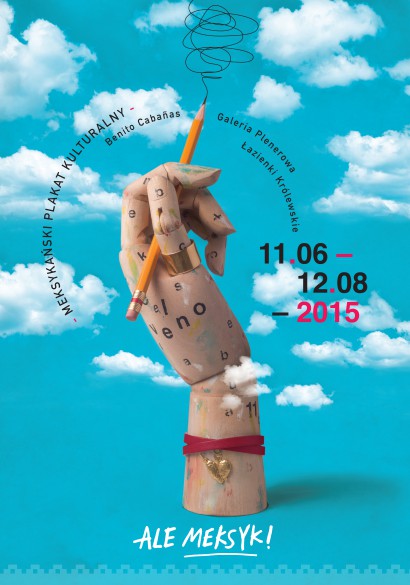Global Design from Puebla
You can’t just walk straight past the eye-catching posters of Germán Montalvo and Benito Cabañas. The motifs they design fascinate contemporary recipients in all corners of the world. The two poster artists make use of the universally understood language of graphic design, in which synthetic signs and symbols are easy to decipher in the context of the cultural events being publicized. However—although the function of the poster to provide information is of paramount importance to the Mexican artists—they do not treat the design work only in terms of its utilitarian value. For them, the ability to convey to the recipients a part of their own sensitivity and imagination, as well as to make a commentary on reality, is of equal importance. “A poster is like a poem,” claims Germán Montalvo.
The basis of the Mexican poster artists-cum-poets’ activity is—to quote Zbigniew Herbert—a recurring dialogue with concrete reality, “with this table, this fellow human being, with this time of day”. Cabañas “contemplates upon” the simplest objects of every-day life which are common to all people anywhere in the world: brooms, flowerpots, crayons, bottle caps…, whereas Montalvo creates modern day monsters taken from the mythology of his Aztec ancestors. Cabañas is interested in creating art for recipients from various cultural spheres; Montalvo analyses the concrete reality of today’s Mexico with its traditions and past, thereby attempting to provoke the recipients into reflecting upon his or her own cultural identity, although his vernacular projects are also perfectly understandable to recipients outside Mexico.
The work of these two graphic artists, who originate from the same town, clearly shows that the idea of a “national school” has ceased to have a raison d’être, and that global design does not have to be synonymous with unification because the merging and transfer of various cultural ideas not only increases the common knowledge required to understand other cultures, but also leads to an enrichment of the repertoire of universal symbols.
The Art of Asking Questions
Every morning, Benito Cabañas devotes ten minutes of his time to sharpening his intellect by creating graphic “short-cuts” to self-selected, always positive themes. What is important is discipline, speed and creativity. It is about creating a synthetic sign which does not only illustrate the theme but comments upon it. It is not a literal answer, but a question to which the onlooker must make an effort to find an answer. For the artist, it is a pleasant way of starting the day. His mini-posters, which are placed on a social networking site, are his way of saying “Good Morning” to the world.
Benito Cabañas would have certainly been an ideal pupil of Henryk Tomaszewski whose teaching methods were based on stimulating his students’ intellect by setting them tasks which involved creating graphic commentaries for various, often abstract slogans and sayings. While Benito Cabañas’ approach to posters alludes to that of the Polish school of posters, his craft, as he himself admits, results from his fascination with the work of Parisian graphic designers. His posters have a close affinity with the output of Michał Batory and Michel Bouvet. What betrays the artist’s Mexican origins is his use of intense colours. However, Cabañas does not try to dazzle the onlooker with them. Much of his work is made using neutral muted tones, although he does use intense magenta and yellow tones for Mexican subjects. Benito Cabañas multiple influences pose a question about the identity of his work. His answer to this question goes beyond national or cultural contexts. He creates intriguing signs and puzzles or questions which are then deciphered by the recipients in Puebla, Paris and Warsaw.
Katarzyna Matul
Benito Cabañas (b. in 1974 in Córdoba, in the state of Veracruz, Mexico) studied graphic design at the University of the Americas in Puebla (UDLAP) in the years 1993–1999. Founder of the Abracadabra design studio in Puebla. Chairman of the Coordenada 21 Designers’ Association in Puebla. Ambassador of Latin American design for the Council of Ambassadors at the University of Palermo in Argentina. He worked for the Anatome agency in Paris and was the design consultant for UNESCO in Paris. In 1999 and 2000 he was awarded the Quorum prize. In 2000, together with the Anatome agency, he won the special Coup de Coeur prize. He also received an honourable mention at the 8th Triennial of Political Posters in Mons (Belgium).
At UNESCO’s sixtieth anniversary celebrations in Paris (in 2005), his work was displayed at the 60 Years – 60 Posters exhibition. He received an honourable mention at the 1st Anti-AIDS International Poster Competition in Ukraine. In 2006 he was a finalist in the Quanto project in Venice and was awarded a prize for Good 50 x 70 in Milan. In 2007 he again received an honourable mention in the International Poster Competition “Latin America Today”. In 2012 he was awarded a prize for his design for the Revolucien exhibition at the Ibero-American Biennale of Graphic Design in Madrid. He has lectured and conducted workshops at many universities and schools of design in South America and Europe. His work can be found in the collections of the MACAY museum (Museo de Arte Contemporaneo Ateneo de Yucatan in Mexico), at the University of Diego Portales in Santiago (Chile), and the Museum of Contemporary Art and Design in Costa Rica.
Curator: Michał Batory
Coordination: Magdalena Majewska
Texts: Katarzyna Matul
Translation: Anne-Marie Fabianowska
Editing and proofreading: Paulina Sieniuć, Anne-Marie Fabianowska
